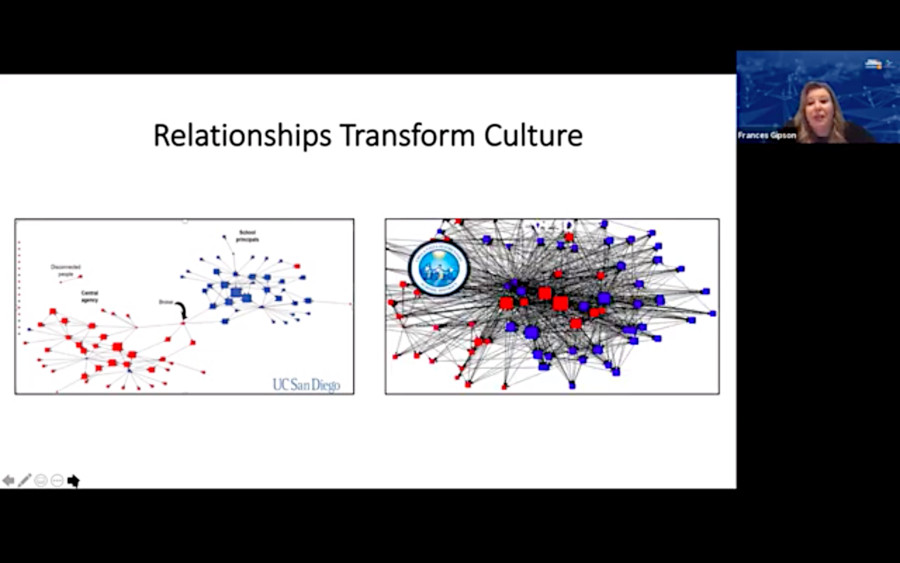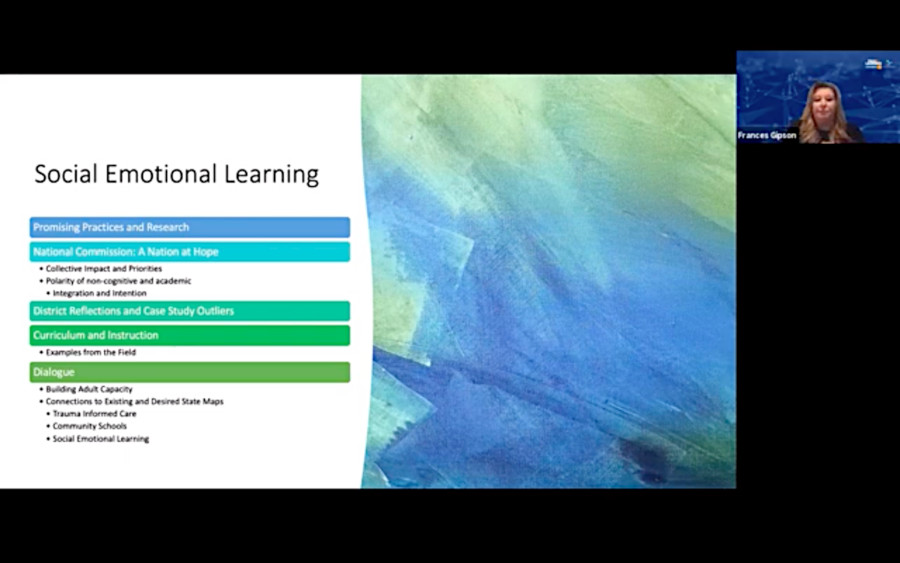Social Emotional Supports for Children and Educators in K-12 Schools
If you are going to lead with love-soaked leadership and put students at the center, the folks that teach you most about yourself is your community.
Frances Gipson has amassed a laundry list of roles and impressive positions during her education career, though perhaps most meaningful to her is “Champion for Team Kid.”
“It’s about putting students at the center and backwards planning from their needs,” says Gipson. “If ever there was a time to really think about those efforts, now is that time. I believe in Love-Soaked Leadership. It’s important to lead with love and be unapologetic about it. One way is to get grounded in our supports around students.”

Why SEL? And when.
True integration isn’t about focusing on SEL 15 minutes and then moving to 45 minutes of Academic focus, it’s more about unpacking a character’s motivations and inner dialogue during a reading lesson, for example. Work that comes out of CASEL helps us think about best practices and intentionality in bringing SEL into the classroom.
Here are three important questions teachers and students can ask themselves as they consider their social emotional wellbeing:
- Self Awareness— What do you know about yourself? How do you bring this monitoring and enlightenment to who you are in this space? How do you self manage?
- Cognitive Coaching— How do we think about responsible decision making? How do we think about relationship skills?
- Context of Culture — What’s your social awareness? It’s so important to put this in the context of culture — this looks different in different places, it’s not a one size fits all. Know your environment.
The Polarity of Non-Congnitive and Academic Emphasis

During the recent “Future-Proofing Your District Plan” Tech & Learning conference, Gipson asked attendees to stop and take a deep breath, and then recognize the body’s natural need to exhale. This nature-inspired example of polarity highlighted the “both/and.” Breathing in and breathing out, breathing out and breathing in — it’s not either or, it’s both/and.
“A polarity is not a problem. Problems are things you can put on a checklist and mark off as you complete it. It requires different ways of thinking— if you are a polarity manager, you manage. If you’re a problem solver, you check it off a list. It’s that difference between technical and adaptive thinking. As you think about stability and change, you can’t say, ‘in this environment I’m not going to attend to students’ Social Emotional needs, just academic needs’— it’s both/and.
Tech & Learning Newsletter
Tools and ideas to transform education. Sign up below.
“As leaders traversing Social Emotional Learning, if you want to stand on that balance ball at the gym, you oscillate a little bit back and forth to stay balanced, rather than seesaw,” says Gipson. “Think about the remote environment and restart environment—how might you help folks stay on the balance ball with this work rather than seesaw?”
Framework for Success in Changing Times
CASEL Framework: The CASEL Framework is depicted through a wheel that identifies five competencies (self-awareness, self-management, social awareness, relationship skills, responsible decision-making) across various settings.
Positive Youth Development (PYD): The five C’s of PYD (competence, confidence, connection, character and caring/compassion) is a research-informed model with specific applications for after-school programs.
The Deeper Learning and 21st Century Skills Frameworks: Illustrates the cognitive, social and interpersonal skills that help young people success in 21st century jobs and civic life.
Sanford Harmony: A free curriculum resource, which includes access to Inspire (teacher aimed) and Institute for Philanthropy. Curated resources on Diversity Inclusion, Problem Solving, Empathy and Critical Thinking. It includes two Learning Pathways — Building Teaching Practices and Developing SEL Capacity.
Another important resource —“From a Nation at Risk to a Nation at Hope” is a landmark report and two-year collaboration using the input of over 200 scientists, psychologists, researchers, educators, youth/parent groups, and policy makers. It demonstrates that social, emotional and academic development are inextricably linked and that investments in Social Emotional programs generate broad social benefits. Positive adult influences must begin early and continue during a child’s entire school career in this effort to educated the “whole learner”.
The Plan Forward
“What shifts or connections are you making?” asks Gipson. “Think about the existing state and the desired state— if we were doing this well, what would it look like and sound like and how would it be resourced? Using that ‘both/and’ polarity mindset, it’s important to recognize that there are good things from your existing state. What do you want to carry over from the existing state and what elements can help in the transformation to the desired state? There are positive things teachers have naturally done, but we haven’t always labeled them. Once we do that, awareness is heightened and we can teach and model it for each other.”
Gipson suggests focusing on how to likewise support the ‘whole educator’ and to remember that part of your teaching team is also your students and parents.
“We’re learning in very new ways now. What might it look like to personalize and connect through relationships? If you are going to lead with love-soaked leadership and put students at the center, the folks that teach you most about yourself is your community.”
Sascha has nearly two decades of experience as a freelance journalist writing for national magazines, including The Washington Post, LA Times, Christian Science Monitor, National Geographic Traveler, and others. She writes about education, travel and culinary topics.

